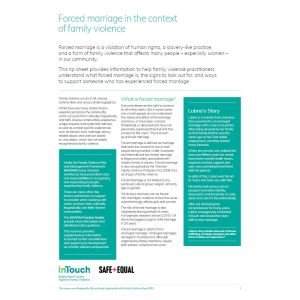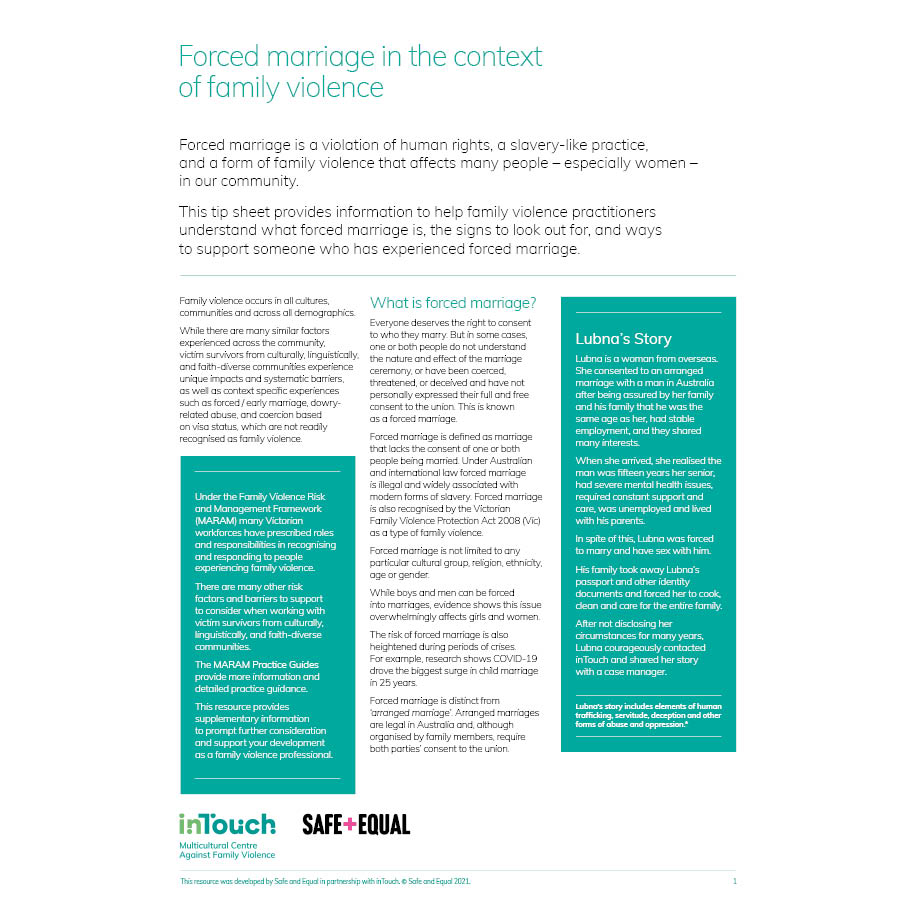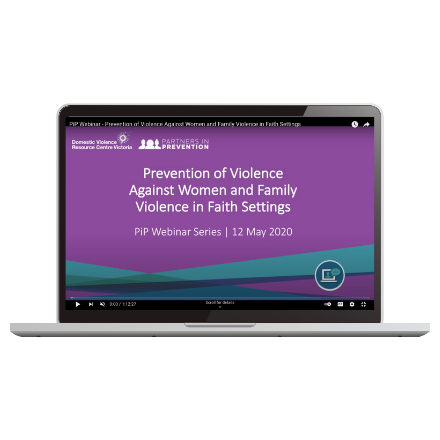This tip sheet provides information to help family violence practitioners understand what forced marriage is, the signs to look out for, and ways to support someone who has experienced forced marriage.

Download
How does family violence affect people from refugee and migrant communities?
Family violence is widespread and is not inherent to any particular culture, country or community. However, people from refugee and migrant communities in Australia are affected by family violence and can face additional risk factors and barriers to support.
These risk factors may include:
- Threats from a perpetrator to immigration, visa status and sponsorship as a form of isolation and control.
- Being financially dependent on a perpetrator due to limited work rights, Centrelink eligibility or bank account access
- Fear of social isolation from culture and community if they choose to reach out to address the violence
- Services potentially sympathising with perpetrators’ experiences of discrimination, and excusing their use of violence.
- Religious or cultural beliefs or expectations that may discourage someone from ending a relationship
These barriers may include:
- Limited access to information about their rights under Australian law and local support services that are available
- Fear or distrust of authorities, such as the police or legal system, due to previous experiences in Australia and/or overseas.
- Racism, social isolation and economic marginalisation
- Limited services available in languages other than English and limited or, access to interpreters
- Lack of culturally safe services that understand the complexities of family violence for refugee and migrant communities
People from refugee and migrant communities may experience some cultural or faith-specific forms of family violence such as forced marriage, dowry abuse, and visa abuse.[1] These are not always widely recognised as family violence. Importantly, these are forms of family violence and are recognised in Victorian law.
Practice considerations
There are many things to consider when supporting a victim survivor from migrant or refugee communities.
- Consider the victim survivor’s cultural context. Cultural stigma, norms, taboos, community pressures, social isolation, or dependency on partners/family members may all influence their experience of family violence.[2]
- Provide support in a culturally safe way. Work collaboratively with the victim survivor, with care and insight for their culture while being mindful of your own.[3]
- Some victim survivors may speak no or limited English. Consider whether you need to use an interpreter, communication aids, or provide information in their preferred language. Check out inTouch’s tip sheet on working with interpreters here.
- Some victim survivors may be scared of engaging with the legal system or police. Take the time to understand these fears and explain how the system works in a way that’s accessible and relevant to the person.
- Particularly for victim survivors who are refugees or asylum seekers, consider the impacts of trauma or violence they experienced in their country of origin.
- Consider that the victim survivor may fear losing their visa status or residency entitlements if they report family violence or seek support. Visa status may also be used by a perpetrator as a tool of coercion or control.[4] Visa status may also affect the victim survivor’s eligibility for services such as Centrelink, housing support or healthcare.[5]
- Work with victim survivors to build understanding of their legal rights and entitlements, including access to financial assistance, compensation and support services. Provide information on duty of care, information sharing schemes and consent limitations to help the victim survivor make informed decisions.
Tools and resources
inTouch Multicultural Centre Against Family Violence is a specialist family violence service that works with women from migrant and refugee backgrounds in Victoria.
As is recognised by the Victorian Family Violence Protection Act 2008 (Vic), forced marriage is a type of family violence. However, as a recent InTouch position paper stresses, the family violence system needs to improve capability to identify and respond to forced marriage in the context of family violence.
To support this we partnered with inTouch to co-design a tip sheet to help family violence practitioners understand what forced marriage is, the signs to look out for, and best ways to support someone who has experienced forced marriage.
Further reading and resources
If you’re a Victorian professional, contact inTouch on 1800 755 988 or fill out an online form for secondary consultation or referral.
Check out inTouch’s resources for professionals on supporting women on temporary migration visas, working with interpreters and intersectionality in practice.
https://intouch.org.au/our-resources/working-with-cald-communities/
[1] Family Safety Victoria (2019). Family Violence Multi-Agency Risk Assessment and Management Framework. Melbourne, Vic: State of Victoria, page 34.
[2] Family Safety Victoria (2019). MARAM Practice Guides: Foundation Knowledge Guide. Melbourne, Vic: State of Victoria, page 49.
[3] Domestic Violence Victoria (2020). Code of Practice: Principles and Standards for Specialist Family Violence Services for Victim-Survivors. 2nd Edition. Melbourne: DV Vic.
[4] Family Safety Victoria (2019). MARAM Practice Guides: Foundation Knowledge Guide. Melbourne, Vic: State of Victoria, page 49.
[5] InTouch (2020) Women on temporary visas experiencing family violence, Melbourne: inTouch. Retrieved at: https://intouch.org.au/wp-content/uploads/2020/06/inTouchTipSheet_WomenOnTemporaryVisasExperiencingFamilyViolence_Website.pdf


